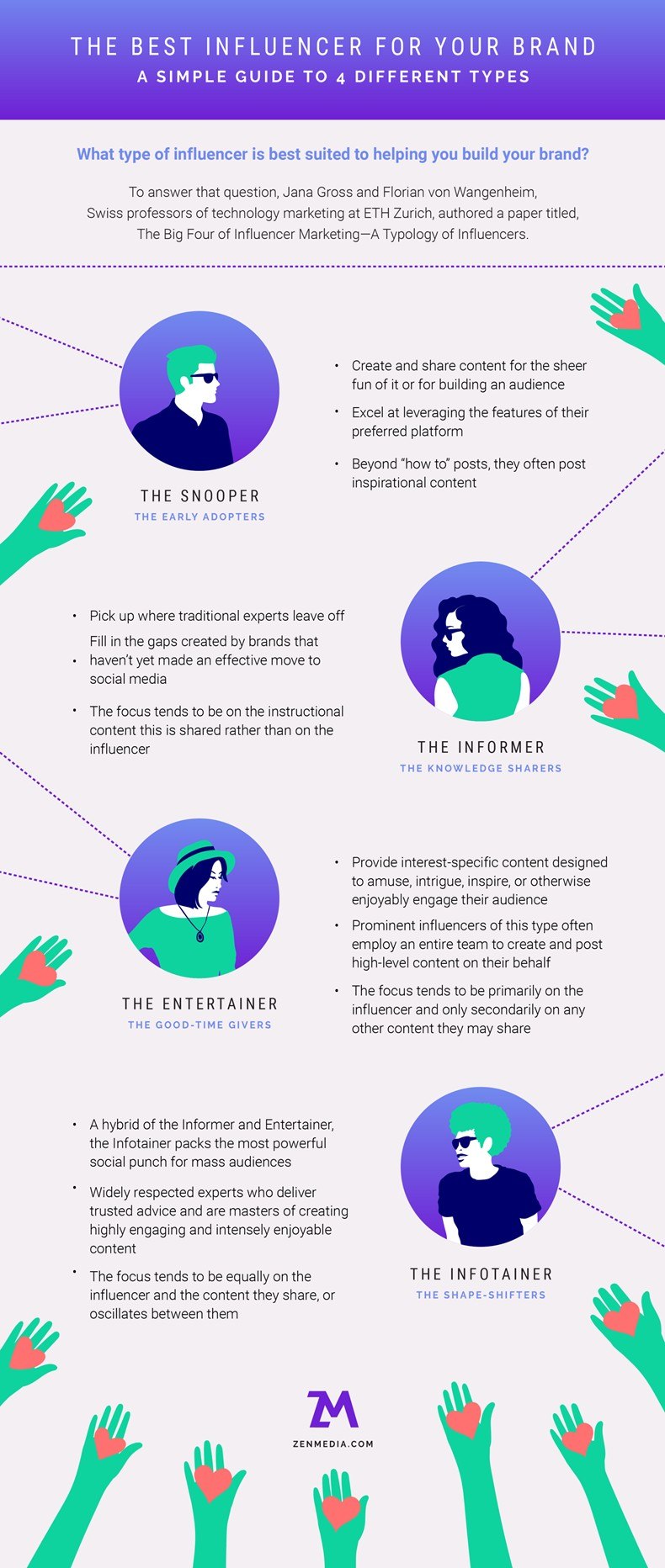It's fairly easy to draw a distinction between a Kardashian and, say, Bill Nye the Science Guy. One fills people's heads with amazing discoveries and evidence of life in other worlds, helping you imagine lifetimes you can only dream of. The other teaches you science facts.
But do we think to draw distinctions when diving into influencer marketing campaigns? Probably not well enough. Which often means we don't select the right influencers for our audience.
The simple truth is there are various types of influencers. Each of them brings varying degrees of success in delivering what your business wants from investments in sponsored content, endorsements, or long-term cooperation. A logistics management software company attempting to sponsor some level of involvement with, say, Dr. Kevin Lyons, a Rutgers University professor and supply chain management expert, is going to look very different from—and produce different results than —if the company partnered with Gary Vaynerchuk.
Knowing those differences going into an influencer partnership, or just a pitch to create one, can help your business define goals, activities, and measures of success for the relationship.
Types of Influencers
To better define and understand the various types of influencers, I looked beyond my own experience to offer something more credible. The academic study of influencer marketing is just beginning, but there are some nuggets of research wisdom out there to learn from.
One such study is an interview-based project conducted by Jana Gross and Florian von Wangenheim, Swiss professors of technology marketing at ETH Zurich. Their paper titled "The Big Four of Influencer Marketing—A Typology of Influencers" produced insights that certainly correlate to my practitioner experiences.
Gross and von Wangenhem's four influencer types are as follows:
- The Snooper. These are early adopters of social media sites who's involvement revolves around the fun of the platform to create and share content. They play on social networks as a hobby or passion and seem to focus on building an audience there. (Though, in my experience, this type of influencer often doesn't do anything with the audience other than continue to celebrate the platform itself.)
They are great at showing others how to maximize the use of one network or another, and often venture into the inspirational content, beyond just "how to do" this or that. - The Informer. This segment of influencers is focused on sharing knowledge. They fill the gaps left by traditional experts who either haven't moved over to using social media or don't come across as genuine enough in our new media world.
If you're willing to agree that gossip news is "information," Perez Hilton became famous in the role of Informer. The Hollywood entertainment and gossip rags weren't on social media when he emerged. He filled the gap. Similarly, a Robert Scoble and Leo LaPorte filled the gap for technology-minded audiences on social networks when executives or experts at Sun, Oracle, HP, Apple, and others were treating social media as a fad.
Most of the contributors to MarketingProfs, including me, fall into this category. - The Entertainer. As you would expect, entertaining influencers see themselves as providing, "amusement, enjoyment, and relaxation," to their audiences. They give their fans a good time with humor, drama, music, art, or just peeks into their daily lives, often with a personal touch. The research also points out that although they may seem like one person who is really engaging, they often have teams of people behind the scenes helping them to create high-level content.
If you don't buy the gossip as "information" assertion, Perez Hilton belongs here. But these are going to be people like one of my favorite influencers, Tiffany Mitchell (Tifforelie). She shares a lot of her personal life and inspires people with her style and design, but she isn't really a provider of how-to-type content. - The Infotainer. The cross between the informer and entertaining is perhaps the biggest and most powerful type of influencer for mass consumers. These people are generally well-read experts in their domain; however, the entertainment value of their content takes precedence. It's one thing for Vintage Revivals blogger Mandi Gubler to give people the steps she used to create her niece's nursery; it's another to produce awesome videos of the reveal, creating an entertaining experience.
Keep in mind that these are four very broad categories. There have almost always been gray areas. An informer can also be entertaining, or a snooper can become an informer. But categorizing the types of influencers you're working with, and understanding the differences, can help you optimize your influencer campaigns.
(See below for an infographic that B2B marketing and PR agency Zen Media put together based on these four archetypes.)
How Categories of Influencers Help Your Brand
The primary reason you should understand and categorize your influencers in some way, even if not the four that Gross and von Wangenheim developed, is that your decision-making will be more informed.
Categorized influencers mean...
- Your requests for content will be more suitable. Giving Entertainers a bunch of how-to content ideas will simply get them, and their audiences, lost. That's not what they do, nor is it why people follow them.
- Your calls to action will be more effective. Expecting Snoopers to convince people to download your whitepaper on transactional efficiency in financial software won't work. Having them ask their followers to follow you on LinkedIn because you provide great tips on using financial software might.
- Your expectations for their impact on your KPIs will be better managed. Entertainment-driven influencers should be expected to entertain. The clickthrough rates and conversions you can expect from them won't be as high as from Informers, who can add "Check out Company X's helpful guide" to the end of their to-do list for a certain project.
Categorize Your Influencers Your Way
However you divide your influencers, add a layer based on the types of content they provide and audiences they engage. Doing so helps you pick the right influencers for the right types of messaging and activities you're executing. It also helps you pick the right types of content either they or you create to execute.
And, in the end, categorizing your influencers by content types and audiences helps whatever success metric you're trying to drive turn out better than if you didn't.





